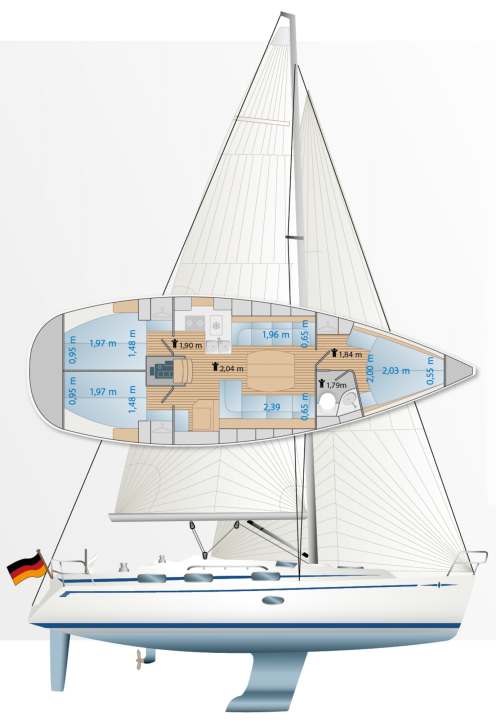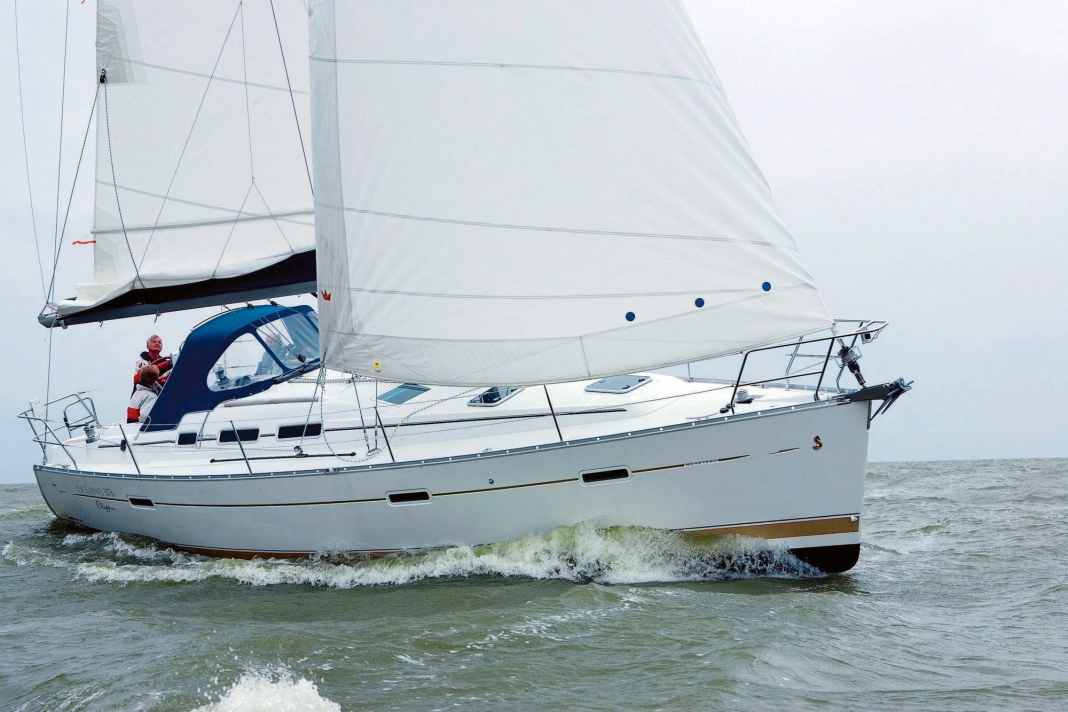





Do you have a budget of 70,000 euros to buy a boat and perhaps a little extra for minor maintenance work? Are you looking for a fully-fledged, seaworthy cruiser with space for up to six people that has proven itself in the tough yacht charter business? We have something for you.
Then the Bavaria 37 Cruiser might be something for you. The boat was built from June 2005 to November 2007, in the impressive number of over 800 units. Derivatives preceded and followed it and should also be considered when buying a used boat.
37 feet, a healthy size. Easy to handle for two or even alone, comfortable and spacious with a decent galley, cosy berths and a proper bathroom. Boats of the generation presented here are still moderately wide and have a draught of less than two metres. These are dimensions that are also suitable for northern European waters. But what characterises the Bavaria 37 Cruiser in particular, where are the disadvantages compared to modern boats, where are the advantages?
Read more about the shipyard:
Test in Großenbrode at the marina of Yachtwerft Klemens. Holger Marquardt from Hörsten in Lower Saxony made his 37 "Anni" available to us. The former signalling technician bought the boat, which was built in 2006, second-hand in 2016 for 73,500 euros. When it was launched new, it was offered for 93,500 euros, which was well below the expectations of the competition, who were asking 30,000 to 40,000 euros more at the time. Well equipped - i.e. with more expensive features such as sprayhood, autopilot, heating and electric anchor winch - it cost just under 114,000 euros new, which is still a low price.
You can definitely see the age of the test boat lying astern on the jetty. From today's perspective, the stern is only moderately wide. There is no stern flap, just a stepped stern. And in the rounded cockpit, only a very small wheel is installed on a massive pillar with a large instrument panel. The overall lines are rounded rather than angular and angular, with individual windows, a sloping stern and bow and a slightly convex, rounded stern. Internal jibs and a clearly overlapping foresail are further features of times gone by.
The Bavaria 37 Cruiser under sail
Overall, the boat looks more comfortable than agile. Or let's put it more bluntly: from today's perspective, it looks ponderous. And it proves us wrong once the high-set genoa is unfurled and the conventional battened main is set. The foresail is quite new and still looks passable, but the main is through. And yet: the speed values are impressive. Over 6.5 knots are achievable at the cross, with good tacking angles and on rougher courses, the eight is quickly on the clock.



The whole thing at 4 Beaufort and a moderate wave, which the boat cuts swiftly with only a slight pitching motion. At times, the boat merely pops and indicates a weight that appears to be higher than the factory specification of 6.9 tonnes.
Overall, however, the values are remarkable, especially in view of the orientation towards a pure touring boat, which is already shown by the ratio of sail area to weight: the sail carrying capacity is just 4.3, even with the battened mainsail. A furling mainsail was also offered and will reduce the performance somewhat. A 1.60 metre deep keel was also available for the 37 Cruiser instead of the 1.95 metre.
The Bavaria 37 Cruiser on deck
The helmsman sits comfortably on the 100-centimetre diameter wheel, but cannot see the headsail threads optimally from there. The cockpit coaming is too narrow to sit on and the wheel would be too far away. A 120-centimetre model could be installed, but then it would be very difficult to pass it; the typical disadvantages of the single-wheel steering gear. In addition, the steering system is somewhat sluggish, which may be due to the autopilot not disengaging. Both aspects dampen the joy of steering somewhat.
From the wheel, the helmsman can easily reach the derivative of a German Cupper system, which is a 1:4 sheared tackle that sits on the coachroof and is led forwards on both sides, down to the deck and aft to the secondary winches. However, there are also 37 cruisers with a mainsheet operated on the coachroof. The genoa sheets are run further forward on the primary winches (which are too small as standard as 40s, as on so many boats); this means that the boat is only suitable for single-handed sailing to a limited extent without an autopilot.
There are no major anomalies under engine power. Volvo's more powerful 40 hp unit and a three-bladed folding propeller were installed on the test boat. At cruising speed, the boat reached 7.5 knots at a tolerable noise level.
The space below deck is surprising
Also worth mentioning: the thwarts are 1.90 metres long and comfortable, the cockpit is comfortable both sitting and lying down. Sailors sitting upwind are supported by the dominant steering column, but this also restricts the room to manoeuvre. There is plenty of it below deck. The boat was offered with two or three cabins. In the three-cabin version, the bathroom is located in the foredeck, which creates a surprising amount of space in the saloon. In the two-cabin version, the head compartment moves aft and shares the space freed up by the omitted cabins with a huge locker, creating even more space forward while the saloon remains free.
With two cabins in the stern, the overlying forecastle compartments are quite shallow and therefore small, at best long enough for fenders, lines and some tools and accessories. With the large forecastle, things get more comfortable: bicycles, inflatable boat and cake stand can then also be easily accommodated. However, the tanks are also located in the stern. Once they have been filled, the forecastle boxes used and the cockpit occupied, the 37 Cruiser becomes quite stern-heavy.
Lighting and power supply could be improved
The tanks in the stern provide plenty of storage space under the saloon and forward berths, and many lockers and cupboards have also been installed. The comfort dimensions are also generous. The saloon is 1.90 to 2.04 metres high and the aft bathroom is still 1.86 metres. The bunk in the bow is a full 2.00 metres wide and the one in the stern is still just under 1.50 metres. These are all very good values for a ship of this generation, which are usually narrower and tighter, especially in the aft cabins.
Quite large windows, hull windows and two panoramic windows as well as a centre hatch provide plenty of light in the boat. The superstructure windows can be opened and the cupboards have ventilation slots. Another practical feature: the unusual-looking ceiling made of GRP frames and covered panels allows access to bolt nuts and cables, which is an advantage not to be sneezed at compared to today's standard inner shells.
However, the design is sparse: there are few light sources and no indirect comfort lighting, and the number of sockets is scarce. The owner has to put up with this or do it himself. There are also fittings such as the cabinet hinges that are not corrosion-resistant. Also worth mentioning are the paintwork, which can be quite heterogeneous, and the grain pattern, which sometimes appears somewhat wild and inharmonious. Otherwise, the visible quality of the interior is solid and durable, with robust mouldings, solid edges and lots of solid wood. This also applies to the GRP work.
Good osmosis resistance
The sandwich hull with a foam core above the waterline is laminated with isophthalic acid resin and a powder-bonded mat on the outer long side. This measure stands for good osmosis resistance and was a good mass production standard at the time. The very generously designed floor assembly, which braces the hull from the stem to the stern, is laminated over a large area and not just glued. The beams of the jetties and the angle laminate of the main bulkhead also look rock solid.
The bow area is reinforced with aramid fabric to protect the boat in the event of a collision; a measure that used to be popular but is more a creative marketing ploy than an actual requirement, as the stem is the strongest part of a yacht and the foredeck is hardly at risk anyway.
Conclusion
The Bavaria 37 Cruiser may lack a certain sailing finesse in terms of steering and deck layout from today's perspective. But even then it offered the comfort of a contemporary yacht. The price of the new yacht was highly attractive, and the price of the second-hand boat still is today. Anyone looking for a boat of this size should consider the Bavaria and weigh it up carefully against the other boats on offer.
YACHT review of the Bavaria 37 Cruiser
Not exciting, but solid. Not a performer, but agile, not cheap, but affordable. The 37 Cruiser hits the middle ground and is a used boat tip for pure cruising sailors.
Design and concept
Lots of volume, large salon
Clear alignment
Large Genoa Standard
Sailing performance and trim
Decent sailing performance
Little cloth for light wind
Seating position on the bike
Living and finishing quality
Solid construction
Good GRP and woodwork
Bath aft or forward
Relatively narrow cockpit
Equipment and technology
High-quality components
Winches too small
The Bavaria 37 Cruiser in detail

Technical data of the Bavaria 37 Cruiser
- CE design category: A
- Torso length: 11,20 m
- Total length: 11,35 m
- Waterline length: 9,82 m
- Width: 3,80 m
- Draught/alternative: 1,95/1,60 m
- Mast height above WL: 15,45 m
- Theoretical torso speed: 7.61 kn
- Weight: 6,9 t
- Ballast/proportion: 2,0/29 %
- Mainsail: 28,9 m²
- Furling genoa (106 %): 39,0 m²
- machine (Volvo P.): 20 kW/27 hp
- Fuel tank: 150 l
- Fresh water tank: 210 l
- Holding tank: 70 l
Model history
The 37/38 size is one of the shipyard's most frequently built models. Around 850 units of the 37 Cruiser were sold to buyers. The boat was replaced by the 38 Cruiser in 2007. This was followed in 2010 by the Cruiser 36, a Farr design, which was replaced in 2013 by the Cruiser 37, which is still being built today.
Market situation
The numbers were high, the type is represented on the market correspondingly often and can be found in many European countries. There are many charter ships on the market, which must be taken into account when viewing and pricing.
Pay attention to this
There should be no maintenance backlog, the saildrive sleeve, underwater hull, toilet hoses, sails and tarpaulins as well as the running rigging should preferably have less than ten years on the clock at the time of purchase.
Equipment and prices
- Base price 2006: 95,300 euros
- Used price: from around € 70,000
Shipyard
Bavaria Yachtbau, Giebelstadt; www.bavariayachts.com
Used alternatives to the Bavaria 37 Cruiser
Similarly stocked used vehicles are diverse and just as affordable. Read the used boat test of the Hanse 370 here.






